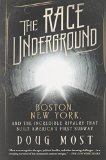Summary | Excerpt | Reviews | Beyond the Book | Readalikes | Genres & Themes | Author Bio
Boston, New York, and the Incredible Rivalry That Built America's First Subway
by Doug Most

Critics' Opinion:
Readers' Opinion:
First Published:
Feb 2014, 352 pages
Paperback:
Feb 2015, 432 pages
 Book Reviewed by:
Book Reviewed by:
BookBrowse First Impression Reviewers
Buy This Book
Beach's proposal went nowhere. The newspapers ridiculed him and New Yorkers sneered. Who would risk going down there under the streets and sidewalks? That's where you go when you're dead. It was ludicrous. "It's better to wait for the Devil than to make roads down into hell," one critic said of the idea of subways. Only somebody who worked at a science magazine would believe something so outrageous could actually work. On and on the criticism went. Reluctantly, Beach took the hint and moved on.
On March 4, 1861, ignoring the advice of those who feared for his safety, the president-elect, Abraham Lincoln, decided to travel through the streets of Washington to his inauguration with President James Buchanan. Together, in a horse-drawn carriage, they rode from the Willard Hotel to the steps of the Capitol Building. In the two months leading up to the inauguration, Texas, Georgia, Alabama, and South Carolina had seceded from the Union, and a civil war appeared unavoidable. Yet in his speech Lincoln promised peace unless an attack on his people left him no choice.
"There needs to be no bloodshed or violence," Lincoln said, "and there shall be none unless it be forced upon the national authority." Five weeks later it was, with the first shots fired at Fort Sumter. Not even the Civil War, however, would slow the transportation revolution under way. On January 9, 1863, nine days after Lincoln ended slavery by signing the Emancipation Proclamation, workers in London achieved one of mankind's greatest industrial breakthroughs. After four years of digging through mostly thick clay and rock, London opened the world's first subway.
But while London's subway, which came to be called the Underground, proved that a long tunnel could be built beneath a city to carry trains and move millions of passengers, it had numerous fundamental flaws. Those trains were powered by steam, and from the very first day the tunnels were filled with dark soot, black smoke, and showers of sparks that made for an altogether miserable traveling experience. Even the chief inspector of railways in Great Britain, Captain Douglas Galton, cautioned other cities from following London's lead. "An underground road is enormously expensive to construct," he said. "It greatly interferes with street traffic during construction, from the large quantities of material to be removed and brought to the surface; it can never be wholesome or free of deleterious gases, and in foggy weather it is always full of thick atmosphere, which increases the liability to accident and is very disagreeable to passengers." A rousing endorsement to a historical achievement it was not.
Beach believed the air in a subway had to feel no different than the air above ground, and just like he had taken apart the typewriter and made it better, he set to work to improve upon London's breakthrough. Five weeks after the underground Metropolitan Railway opened (and introduced "the metro" into the lexicon of transportation), Beach found his inspiration.
Excerpted from The Race Underground by Doug Most. Copyright © 2014 by Doug Most. Excerpted by permission of St. Martin's Press. All rights reserved. No part of this excerpt may be reproduced or reprinted without permission in writing from the publisher.





The House on Biscayne Bay
by Chanel Cleeton
As death stalks a gothic mansion in Miami, the lives of two women intertwine as the past and present collide.

The Flower Sisters
by Michelle Collins Anderson
From the new Fannie Flagg of the Ozarks, a richly-woven story of family, forgiveness, and reinvention.

The Funeral Cryer by Wenyan Lu
Debut novelist Wenyan Lu brings us this witty yet profound story about one woman's midlife reawakening in contemporary rural China.
Your guide toexceptional books
BookBrowse seeks out and recommends the best in contemporary fiction and nonfiction—books that not only engage and entertain but also deepen our understanding of ourselves and the world around us.